#Lightweight UI Frameworks
Explore tagged Tumblr posts
Text
i feel like this is at least partly a result of the comfortable unified environment provided by a full framework. cooperation between the frontend and backend for shit like multipart forms or validation is silly. but like, ideally there would be a better choice than react for a lot of stuff. there are a lot of interesting pushes in this direction though- i used to be really into liveview and alpine, and it seems like people like svelte and vue
Feel like the ultimate question of web deployment is "does this even need to be an application" and part of the reason everyone hates web developers is that the answer *would* be no in most cases if not for a whole bunch of dynamic content that no one who visits the website actually wants.
if you didnt have ads and trackers and banners and email signup popups and comments sections full of spam and trolls, you'd just be serving some text with images 99.999% of the time and none of the webdev gack would be necessary. You only gamble on the added bloat paying for itself despite the massive added bandwidth cost because otherwise the amount you're getting paid is "zero"
#i think it goes#0 state -> static#UI state -> lightweight framework or bare js#almost any non UI state -> react#honestly dont think theres a place for wordpress but that could be trauma from having to maintain people's awful instances
53 notes
·
View notes
Text
What is Mern stack And Its importance? Before that I will Tell you the best institute for Mern stack course in Chandigarh.

What is Mern stack?
MERN Stack is a popular JavaScript-based technology stack used for building full-stack web applications. It consists of four key technologies:
MongoDB: A NoSQL database that stores data in a flexible, JSON-like format.
Express.js: A lightweight and fast backend framework for Node.js.
React.js: A front-end JavaScript library for building user interfaces.
Node.js: A runtime environment that allows JavaScript to run on the server side.
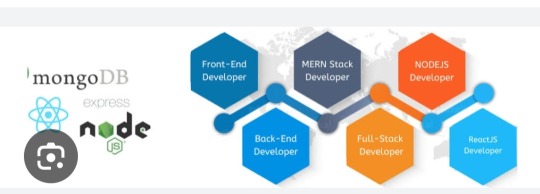
Importance of Mern Stack :
Full-Stack JavaScript – Uses JavaScript for frontend and backend, simplifying development.
High Performance – Node.js ensures fast, scalable applications.
Cost-Effective – Open-source, reducing development costs.
Rapid Development – React’s reusable components speed up UI building.
Flexibility – Suitable for web apps, SPAs, eCommerce, and real-time applications.
Scalability – MongoDB handles large data efficiently.
Strong Community Support – Large developer base ensures continuous updates and support.
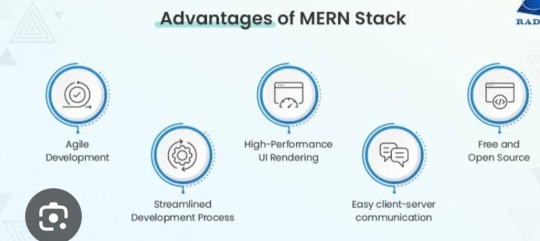
Now i will tell you the best institute for Mern stack course in Chandigarh .
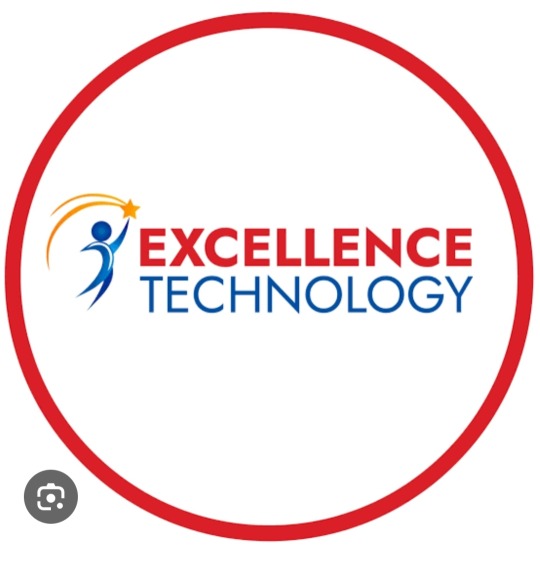
Excellence Technology is a leading EdTech (Educational technology) company dedicated to empowering individuals with cutting -edge IT skills and bridging the gap between education and industry demands. Specializing in IT training ,carrer development, and placement assistance ,the company equipts learners with the technical expertise and practical experience needed to thrive in today's competitive tech landscape. We provide IT courses like python ,Full stack Development, Web Design ,Graphic Design and Digital Marketing.
Contact Us for more details: 93177-88822
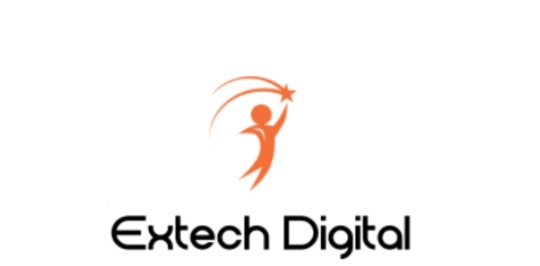
Extech Digital is a leading software development company dedicated to empowering individuals with cutting -edge IT skills and bridging the gap between education and industry demands. Specializing in IT training ,carrer development, and placement assistance ,the company equipt learners with the technical expertise and practical experience needed to thrive in today's competitive tech landscape. e provide IT courses like Python ,Full stack Development, Web Design ,Graphic Design and Digital Marketing.
Contact Us for more details: 93177-88822

Excellence academy is a leading software development company dedicated to empowering individual with cutting edge IT skills and bridging the gap between education and industry demands.specializing in IT training, career development, and placement assistance, the company equits learners with the technical expertise and practical experience needed to thrive in today's landscape. We provide IT courses like python, full stack development,Web design, and Digital marketing.
Contact Us for more details: 93177-88822
About Author
Nikita Thakur
Mern stack AI Developer/ 2+ years of experience
Excellence technology
Professional summary
Nikita thakur is a skilled MERN Stack AI Developer with over 2 years of experience at Excellence Technology. Proficient in MongoDB, Express.js, React.js, and Node.js, she integrates AI solutions to build scalable, high-performance web applications. Nikita excels in developing innovative solutions, enhancing user experiences, and driving business growth through technology.
2 notes
·
View notes
Text
Pure JS Notification System Inspired by Bootstrap 5 - ZephyrToast
ZephyrToast is a lightweight JavaScript notification library that creates elegant customizable toast notifications inspired by Bootstrap 5 styling. It delivers a clean solution for displaying transient messages to users without the bloat of larger UI frameworks. Features: Multiple notification types: Success, Info, Warning, Error Six different positioning options: Top-right, Top-left,…
1 note
·
View note
Text
Component Libraries: Should You Build Your Own or Use a Prebuilt One?

Component libraries are a vital tool in web application development in maintaining uniform design, shortening the time taken to develop web applications and improving reusability of the code. Some developers find this dilemma; should they create a component library or use an existing one? In addition, they help reduce the struggle while building well-designed and interactive websites because of the availability of animation-oriented UIs such as Accentricity UI among others. Now, let’s get more to the point in order to help you find the right way.
What is a Component Library?
Component libraries are collections of reusable UI elements such as buttons, forms, modals, and more— and are intended to reuse the components across several projects. Such libraries not only guarantee a consistent look of an application but also save time and costs during its implementation because the elements have been already coded. So, there's no need to build components from scratch.
Prebuilt Component Libraries

Prebuilt Component Libraries
Prebuilt component libraries are the ready-made collections of different UI components that are specifically designed and optimized for common use cases that developers can face during development. Some well-known examples include:
Material-UI (MUI):
A library based on React and it follows Google's Material-UI design, MUI allows a comprehensive set of components customization.
Ant Design:
It's an UI design system framework for enterprise-level products, ant design offers built-in themes and a rich set of UI components.
Bootstrap:
It's an widely-used CSS framework that provides basic components and a responsive grid system.
Pros of Prebuilt Libraries :
Rapid Development: Prebuilt libraries save a lot of time of the developers by providing pre-designed reusable components that you can quickly integrate into your project.
Standardized Design: They help ensure a consistent user experience across different screens and features.
Community Support: Many prebuilt libraries come with robust community support, providing a wealth of tutorials, plugins, and enhancements.
Cons of Prebuilt Libraries
Limited Customization: Customizing components to fit your unique design can sometimes be difficult, leading to constraints on flexibility.
Performance Overhead: Many prebuilt libraries come with extra features you may not need, which can bloat your codebase.

Pros And Cons of Prebuilt Libraries
Animation-Centric Libraries: Bringing UIs to Life
In recent years, a new category of libraries has emerged, specifically focused on providing built-in animations and smooth UI transitions. These libraries not only offer pre-designed components but also emphasize adding dynamic, interactive features to web applications.
Here are some popular examples of animation-focused libraries:
Lottie
Category: Animation Integration Library

Lottie:The industry standard for motion design
What it Offers: Lottie allows you to render animations created in Figma or Adobe After Effects as JSON files using the built-in plugins. These animations are then rendered natively on the web, offering high-quality motion without a heavy performance impact.
Why It’s Useful: Lottie is perfect for apps or websites requiring rich, scalable animations that are lightweight. It’s commonly used for logos, loading animations, and subtle UI effects. Unlike other component libraries, it focuses purely on bringing visual design elements from tools like Figma & After Effects into the web environment.
Accentricity UI
Category: Hybrid Component and Animation Library
What it Offers:
Accentricity UI combines traditional UI components with built-in support for smooth animations and transitions. It offers a wide range of components like buttons, forms, modals, and navigation menus, but with an added layer of predefined animations, making it easier to create interactive, dynamic interfaces.
In addition to these standard components, Accentricity UI provides responsive behaviors and subtle animation effects like hover states, fade-ins, and sliding transitions that enhance user engagement. The library's components are fully customizable, allowing developers to easily adjust animation timings, easing functions, and durations to match the look and feel of their brand, ensuring both visual appeal and performance across devices.
Why It’s Useful:
Think about it, what would be easy for a dev? Making a custom component with tons of animation which the dev has to write from scratch and polish it before the deadline or use a library, where the dev can make use of the library with the built-in support to combine the custom designed elements with smooth animations and transitions offered by the library.
It’s particularly helpful for developers who want the convenience of a prebuilt library but need polished, built-in animations to enhance user experience without writing complex animation code from scratch.
Framer Motion
Category: Animation-focused Component Library (React)

Framer Motion
What it Offers:
Framer Motion is a powerful library for React that allows you to create fluid animations and micro interactions with minimal effort. It supports interactive features like drag, scroll, and spring-based animations, which makes it ideal for interactive & highly animated UIs. It also provides easy-to-use APIs for gesture-based animations and layout transitions, offering developers extensive control over complex animations while maintaining simplicity in implementation.
Why It’s Useful:
Framer Motion combines the simplicity of component libraries with the flexibility of advanced animation frameworks, making it easy to enhance user interfaces with dynamic visual effects. It’s a great choice for React developers who want to integrate animation without compromising performance or adding significant overhead. With its built-in optimizations for smooth rendering, Framer Motion ensures high-quality animations that enhance both usability and visual appeal.
Should You Use Prebuilt Animation Libraries?
The role of animations is really important in web applications to enhance the UX(user experience), by making interfaces feel more fluid and interactive makes user's remember the website due to its great experience. Since users are constantly getting used to smooth effects, micro-interaction and dynamic feedback, animations are no longer viewed as a good to have feature but are rather considered as a must have feature. Prebuilt animation libraries like Framer Motion and GSAP (GreenSock Animation Platform) simplify this process by providing powerful, flexible tools that allow developers to integrate complex animations without having to manually manage every aspect of motion or dive deep into animation theory.
Advantages of Animation-Centric Libraries

Advantages of Animation-Centric Libraries
Ease of Use
Prebuilt animation libraries abstract away the complexities of coding animations from scratch. Without manually writing keyframes, easing functions, or browser-optimized transitions, developers can simply use predefined APIs to implement fluid animations. This drastically reduces development time, as many animation details are handled by the library, letting developers focus on building features and interactions rather than tweaking animations for performance or cross-browser compatibility. For example, with a few lines of code, animations can be applied to any UI element, making the development process much more efficient.
Advanced Features
Many animation libraries offer advanced features that go far beyond basic transitions like fade-ins and slide animations. These include timeline control, scroll-triggered animations, physics-based interactions, and even 3D transformations. For instance, timeline control allows developers to create synchronized sequences of animations, which can be used to create smooth, coordinated interactions across multiple elements. Scroll-based animations enhance user engagement by triggering effects as the user scrolls, perfect for parallax websites or content reveal effects. Physics-based animations, such as spring-based drag-and-drop or object bouncing, add natural, realistic movement to interactive elements, elevating the overall experience. Additionally, 3D transformations provide extensive control over how objects rotate, scale, or move in three-dimensional space, something that is cumbersome to achieve with native CSS alone.
See What Happens Next
#webdevelopement#werbooz#own website#build vs prebuilt component library#custom UI components#prebuilt UI libraries#web development#Material-UI#Ant Design#Bootstrap#Framer Motion#Accentricity UI#animation libraries#best UI libraries 2024#component library pros and cons#web app development#UI design optimization#web performance#web development trends
2 notes
·
View notes
Text
Top 10 Front-End Frameworks and Libraries for 2024
As the web development landscape continues to evolve, staying updated with the latest front-end frameworks and libraries is crucial for any developer. Whether you're a seasoned pro or just starting out, knowing which tools to use can significantly impact your productivity and the quality of your projects. In this post, we’ll explore the top 10 front-end frameworks and libraries that are set to dominate in 2024.
1. React
React remains one of the most popular front-end libraries, known for its simplicity and flexibility.
Key Features of React
Component-Based Architecture: Reusable components make development efficient and manageable.
Virtual DOM: Enhances performance by minimizing direct DOM manipulation.
Strong Community Support: A vast ecosystem of tools, libraries, and tutorials.

2. Angular
Angular, backed by Google, is a powerful framework for building dynamic single-page applications (SPAs).
Why Choose Angular?
Two-Way Data Binding: Synchronizes data between the model and the view.
Dependency Injection: Improves code maintainability and testability.
Comprehensive Documentation: Extensive resources for learning and troubleshooting.

3. Vue.js
Vue.js has gained popularity due to its gentle learning curve and versatility.
Advantages of Vue.js
Reactive Data Binding: Simplifies state management.
Single-File Components: Encapsulate HTML, CSS, and JavaScript in one file.
Flexibility: Can be used for both large-scale and small-scale applications.

4. Svelte
Svelte is a relatively new player that compiles components into highly efficient vanilla JavaScript at build time.
Svelte’s Standout Features
No Virtual DOM: Directly manipulates the DOM for better performance.
Less Boilerplate: Cleaner code with minimal overhead.
Ease of Use: Intuitive and straightforward syntax.

5. Bootstrap
Bootstrap is a front-end framework that provides pre-designed components and a responsive grid system.
Benefits of Using Bootstrap
Responsive Design: Ensures your site looks great on all devices.
Pre-Styled Components: Saves time with ready-to-use UI elements.
Customizable: Easily customize with Sass variables and Bootstrap’s extensive options.

6. Tailwind CSS
Tailwind CSS is a utility-first CSS framework that allows for rapid UI development.
Tailwind CSS Features
Utility-First Approach: Use utility classes directly in your HTML.
Customizable: Extensive configuration options to suit your project’s needs.
Consistency: Enforces a consistent design language across your project.

7. Ember.js
Ember.js is a robust framework for building ambitious web applications.
Why Ember.js Stands Out
Convention over Configuration: Reduces the amount of decision-making and boilerplate code.
Strong Routing: Powerful routing capabilities for managing application state.
Productivity: Focuses on developer productivity with built-in best practices.

8. Alpine.js
Alpine.js offers a minimal and lightweight way to add interactivity to your websites.
Key Features of Alpine.js
Lightweight: Small footprint with only a few kilobytes.
Declarative Syntax: Similar to Vue.js, making it easy to understand and implement.
Ease of Integration: Can be easily integrated into existing projects.

9. Next.js
Next.js is a popular React framework that enables server-side rendering and static site generation.
Benefits of Using Next.js
Server-Side Rendering (SSR): Improves performance and SEO by rendering pages on the server.
Static Site Generation (SSG): Pre-renders pages at build time for fast load times.
API Routes: Allows you to create API endpoints within your application.

10. Lit
Lit is a simple library for building fast, lightweight web components.
Advantages of Lit
Web Components: Embraces the web components standard for reusable, encapsulated HTML elements.
Performance: Lightweight and highly performant.
Simple API: Easy to learn and use with a minimal API surface.

Conclusion
Choosing the right front-end framework or library can significantly impact your workflow and the quality of your projects. Whether you prefer the flexibility of React, the structure of Angular, or the simplicity of Svelte, there's a tool out there to suit your needs.
Final Tips for Selecting a Framework or Library
Project Requirements: Consider the specific needs of your project.
Community and Support: Look for frameworks with strong community support and documentation.
Learning Curve: Choose a tool that matches your current skill level and the time you have available to learn.
By staying informed about the latest tools and trends, you can ensure that your skills remain relevant and that you can deliver the best possible results in your projects. Happy coding!
Remember, the best tool is the one that helps you get the job done efficiently and effectively. So, dive into these frameworks and libraries, and take your front-end development skills to the next level!
Share Your Thoughts
I'm curious to know your thoughts on these front-end frameworks and libraries. Have you used any of them in your projects? Which one is your favorite, and why? Share your experiences and insights in the comments below.👇
2 notes
·
View notes
Text
Frontend Frameworks for Web Development

Frontend Frameworks for Web Development, creating captivating and user-friendly websites and web applications is essential for businesses to thrive. With the increasing demand for dynamic and interactive web experiences, frontend development has become more crucial than ever.
To meet these demands efficiently, developers rely on frontend frameworks, which streamline the development process and enhance productivity.
In this comprehensive guide, we'll explore the world of frontend frameworks for web development, covering everything from key factors to consider when choosing a framework to the top options available in India.
Overview of Frontend Frameworks for Web Development
Frontend frameworks are collections of pre-written code, libraries, and tools that expedite the process of building user interfaces for websites and web applications.
These frameworks provide developers with a structured approach to frontend development, offering ready-made components, templates, and utilities to streamline common tasks.
By leveraging frontend frameworks, developers can achieve consistency, maintainability, and scalability in their projects while focusing more on functionality and user experience.
These frameworks often follow the principles of modularization and component-based architecture, facilitating code reuse and making development more efficient.
Key Factors to Consider in a Frontend Frameworks for Web Development
When choosing a frontend framework for web development, several key factors should be considered:
Community Support: Opt for frameworks with active and robust communities. A strong community ensures ongoing support, frequent updates, and a wealth of resources such as documentation, tutorials, and plugins.
Performance: Evaluate the performance metrics of the framework, including page load times, rendering speed, and resource utilization. A lightweight and efficient framework can significantly impact the user experience.
Flexibility and Customization: Assess the framework's flexibility in accommodating project requirements and its customization options. Look for frameworks that allow developers to tailor components and styles to suit specific design needs.
Learning Curve: Consider the learning curve associated with the framework, especially if you're working with a team of developers with varying skill levels. Choose a framework that aligns with your team's expertise and resources.
Compatibility and Browser Support: Ensure that the framework is compatible with a wide range of browsers and devices, particularly if your target audience includes users with diverse preferences and devices.
Updates and Maintenance: Check the framework's update frequency and long-term maintenance plans. Regular updates and proactive maintenance are essential for addressing security vulnerabilities and compatibility issues.
7 Best Frontend Frameworks for Web Development in India
Now, let's explore some of the top Frontend Frameworks for Web Development widely used by developers in India:
React.js: Developed by Facebook, React.js is a popular JavaScript library for building user interfaces. It emphasizes component-based architecture and virtual DOM for efficient rendering. React's ecosystem includes tools like React Router for routing and Redux for state management.
Angular: Backed by Google, Angular is a comprehensive frontend framework for building robust web applications. It provides features such as two-way data binding, dependency injection, and modular development. Angular offers a full-fledged ecosystem with Angular CLI for project scaffolding and Angular Material for UI components.
Vue.js: Vue.js is an advanced JavaScript framework known for its simplicity and flexibility. It allows developers to incrementally adopt its features and integrate it into existing projects easily. Vue.js offers reactive data binding, virtual DOM, and a rich ecosystem of plugins and components.
Bootstrap: Bootstrap is a popular CSS framework for building responsive and mobile-first websites. It provides a grid system, pre-styled components, and responsive utilities, allowing developers to create sleek and consistent designs quickly. Bootstrap is highly customizable and offers extensive documentation and community support.
Svelte: Svelte is a relatively new frontend framework that focuses on compiling components at build time rather than runtime. This approach results in highly optimized and lightweight web applications. Svelte's simplicity and performance make it an attractive choice for developers seeking efficiency and speed.
Tailwind CSS: Tailwind CSS is a utility-first CSS framework that provides a set of low-level utility classes for building custom designs. It offers a highly customizable and expressive approach to styling, enabling developers to create unique and responsive interfaces without writing custom CSS. Tailwind CSS is gaining popularity for its developer-friendly workflow and rapid prototyping capabilities.
Foundation: Foundation is a responsive front-end framework developed by ZURB, known for its modular and customizable nature. It offers a comprehensive set of CSS and JavaScript components, as well as a robust grid system and a variety of UI elements. Foundation is well-suited for building modern and accessible web projects.
Conclusion for Web Development
Choosing the right Frontend Frameworks for Web Development is crucial to the success of your website development. Consider factors such as community support, performance, flexibility, and compatibility when evaluating different frameworks. Each framework has its strengths and weaknesses, so assess your project requirements and development preferences carefully before making a decision.
Whether you opt for React.js, Angular, Vue.js, or any other frontend framework, prioritize learning and mastering the chosen tool to maximize its potential and deliver exceptional web experiences. Keep abreast of new developments, best practices, and emerging trends in frontend development to stay ahead in this ever-evolving field.
FAQs for Web Development
Q: Which frontend framework is best for beginners?
A: Vue.js and React.js are often recommended for beginners due to their relatively gentle learning curves and extensive documentation.
Q: How do I choose between Angular and React for my project?
A: Consider factors such as project requirements, team expertise, and ecosystem preferences. Angular offers a comprehensive solution with built-in features, while React provides more flexibility and a vibrant ecosystem.
Q: Are frontend frameworks necessary for web development?
A: While not strictly necessary, frontend frameworks greatly simplify and expedite the web development process, especially for complex and dynamic projects. They provide structure, consistency, and efficiency, ultimately enhancing productivity and user experience.
Q: Can I use multiple frontend frameworks in the same project?
A: While technically possible, using multiple frontend frameworks in the same project can lead to complexity, conflicts, and maintenance challenges. It's generally advisable to stick to a single framework to maintain code consistency and streamline development.
More Details
Email: [email protected]
Website: https://censoware.com/
#web development#website development#software development#web developers#pythonprogramming#phpdeveloper#javascriptdeveloper#mern stack development#mobile app development
2 notes
·
View notes
Text
React JS
Unleashing the Power of User Interfaces: A Guide to React.js
In the ever-evolving landscape of web development, creating interactive and dynamic user interfaces is crucial to delivering engaging online experiences. One technology that has risen to prominence in this domain is React.js. Developed by Facebook, React.js has transformed the way developers build web applications by providing a powerful framework for building modular and reusable UI components. In this blog post, we'll delve into the world of React.js, exploring its core concepts, benefits, and practical applications.
Understanding React.js:
At its heart, React.js is a JavaScript library that focuses on the efficient rendering of user interfaces. It employs a declarative approach to building UI components, where developers define how the interface should look at any given point in time, and React takes care of efficiently updating and rendering the UI when data changes.
Key Concepts:
Components: In React, user interfaces are constructed using components - self-contained, reusable building blocks that encapsulate both UI elements and the logic to manage their behavior. Components can be nested within each other, forming a tree-like structure that represents the entire user interface.
Virtual DOM: One of the most powerful features of React is its Virtual DOM. Rather than directly manipulating the actual DOM, React creates a lightweight virtual representation of the DOM in memory. When there are changes in the data or state of a component, React calculates the difference (also known as the "diff") between the previous and current virtual DOM states, and then applies only the necessary updates to the actual DOM. This process greatly improves performance and minimizes unnecessary re-rendering.
State and Props: State represents the dynamic data that can change within a component. Props (short for properties) are immutable data that are passed from parent to child components, allowing for dynamic content and customization.
Lifecycle Methods: React components have a lifecycle, consisting of phases from initialization to rendering, updating, and unmounting. Developers can tap into these lifecycle methods to control behavior at various points in a component's existence.
Hooks: Introduced in React 16.8, hooks are functions that allow developers to add state and lifecycle features to functional components. This enables a more concise and readable code structure, promoting the use of functional components over class components.
Benefits of Using React.js:
Modularity and Reusability: React's component-based architecture promotes modular development. Components can be reused across different parts of an application or even shared between projects, leading to more efficient development and easier maintenance.
Performance: By employing the Virtual DOM and selective rendering, React minimizes the performance overhead of constantly updating the actual DOM. This results in faster, smoother user interfaces, even for complex applications.
Community and Ecosystem: React has a vast and active community that contributes to its ecosystem. This means there are numerous libraries, tools, and resources available to enhance and streamline the development process.
SEO-Friendly: React applications can be rendered on the server side, improving search engine optimization (SEO) by providing search engines with a fully rendered HTML page.
Practical Applications:
React.js finds applications in a wide range of projects, from simple web apps to complex enterprise-level solutions. Some common use cases include:
Single-Page Applications (SPAs): React excels in building SPAs where fluid user experiences are key. Platforms like Facebook and Instagram use React to power their dynamic interfaces.
E-Commerce Websites: React's modular nature is beneficial for e-commerce sites, allowing developers to create reusable components for product listings, carts, and checkout processes.
Data Dashboards: React is suitable for building data visualization dashboards that require real-time updates and interactive charts.
Mobile Applications: React Native, an extension of React.js, is used to develop cross-platform mobile applications with a native-like experience.
In Conclusion:
React.js has revolutionized the way web applications are developed by providing a powerful set of tools for building modular, efficient, and interactive user interfaces. Its component-based architecture, Virtual DOM, and rich ecosystem make it a top choice for developers looking to create modern and engaging web experiences. Whether you're building a personal project or a complex enterprise application, React.js is a valuable technology to have in your toolkit. So, embrace the power of React.js and embark on a journey to create stunning user interfaces that captivate and delight your audience.
6 notes
·
View notes
Text
Top 10 Tools for AI Voice Bot Development in 2025
As we venture deeper into the AI-driven era, voice bots have evolved from simple command-based assistants to sophisticated conversational agents capable of understanding context, emotion, and intent. Whether you’re building a customer support bot, a virtual healthcare assistant, or a voice-powered productivity tool, selecting the right development platform is critical.

Here are the top 10 tools for AI voice bot development in 2025, selected for their innovation, scalability, and integration capabilities.
1. OpenAI Voice (ChatGPT + Whisper Integration)
Best For: Natural language understanding and multi-modal capabilities
OpenAI’s ecosystem has expanded rapidly, combining GPT-4.5/O4 models with Whisper’s speech-to-text prowess. Developers can now build deeply conversational voice bots using OpenAI’s API with support for context-aware dialogue, voice inputs, and real-time response generation.
Key Features:
High-accuracy transcription with Whisper
Real-time, emotional responses using GPT-4.5/O4
Seamless voice interaction via OpenAI’s API
2. Google Dialogflow CX
Best For: Enterprise-grade voice bots with complex flows
Dialogflow CX is Google’s advanced platform for designing and managing large-scale conversational experiences. With built-in voice support via Google Cloud Speech-to-Text and Text-to-Speech, it's a go-to for robust, voice-enabled virtual agents.
Key Features:
Visual conversation flow builder
Multilingual support
Google Cloud integration and analytics
3. Microsoft Azure Bot Service + Cognitive Services
Best For: Microsoft-centric ecosystems and omnichannel bots
Azure Bot Service paired with Cognitive Services (like Speech, Language Understanding (LUIS), and Text-to-Speech) offers developers a flexible framework for voice bot development with enterprise-grade security.
Key Features:
Deep integration with Microsoft Teams, Cortana, and Office 365
Powerful natural language and voice synthesis tools
Scalable cloud infrastructure
4. Amazon Lex
Best For: Building bots on AWS with Alexa-grade NLU
Amazon Lex powers Alexa and offers developers access to the same deep learning technologies to build voice bots. It’s especially useful for those building apps in the AWS ecosystem or needing Alexa integration.
Key Features:
Automatic speech recognition (ASR)
Integration with AWS Lambda for logic handling
Easy deployment to Amazon Connect (for call centers)
5. Rasa Pro + Rasa Voice
Best For: Open-source, customizable voice bots with on-prem deployment
Rasa is a favorite among developers looking for full control over their voice assistant’s behavior. Rasa Pro now includes voice capabilities, enabling end-to-end conversational AI pipelines including voice input and output.
Key Features:
Fully open-source with Pro options
Privacy-first design (on-prem support)
Custom NLU pipelines and integrations
6. AssemblyAI
Best For: High-accuracy voice transcription and real-time speech AI
AssemblyAI provides APIs for speech-to-text, topic detection, sentiment analysis, and more. Its strength lies in real-time audio stream processing, making it ideal for building voice interfaces that require instant feedback.
Key Features:
Real-time and batch transcription
Keyword spotting and summarization
Speaker diarization and sentiment detection
7. Speechly
Best For: Voice UI in mobile and web apps
Speechly is designed for creating fast, voice-enabled interfaces with natural flow and low-latency response. It supports both command-based and free-form voice input, perfect for apps needing intuitive VUIs (voice user interfaces).
Key Features:
Streaming speech recognition
Lightweight SDKs for mobile and web
Real-time intent detection
8. NVIDIA Riva
Best For: On-prem, low-latency voice applications at the edge
NVIDIA Riva leverages GPU acceleration to offer real-time, high-performance voice AI applications. Perfect for companies looking to run AI voice bots locally or at the edge for privacy or latency reasons.
Key Features:
GPU-optimized ASR and TTS
Custom model training and fine-tuning
Edge deployment and on-device inference
9. Descript Overdub + API
Best For: Personalized voice synthesis and cloning
Descript, known for its AI-based audio/video editing tools, also offers Overdub—its synthetic voice technology. With API access, developers can integrate lifelike, personalized TTS into their bots using cloned voices.
Key Features:
Realistic voice cloning
Easy editing and text-to-audio conversion
Ideal for media, podcasting, and character-based bots
10. Vocode
Best For: Real-time conversational voice bots using LLMs
Vocode is a developer-first platform designed to create real-time voice bots powered by large language models like GPT. It manages both speech recognition and TTS with low-latency pipelines.
Key Features:
Plug-and-play LLM integration
Streaming TTS/ASR
Fast API setup for voice-first agents
Conclusion
In 2025, building AI voice bot development isn’t just about basic speech recognition — it’s about crafting lifelike, responsive, and intelligent conversational experiences. Whether you're creating a support bot, in-app voice assistant, or a voice-enabled game character, the tools above offer powerful capabilities across every need and scale.
Choose based on your priorities — open-source flexibility (Rasa), real-time streaming (Vocode/Speechly), enterprise integration (Dialogflow CX/Azure), or next-gen LLMs (OpenAI). The future of voice bots is not only conversational but deeply contextual, personal, and proactive.
0 notes
Text
Profile-Pro - Ultimate Personal Portfolio Template
LIVE DEMO | BUY NOW
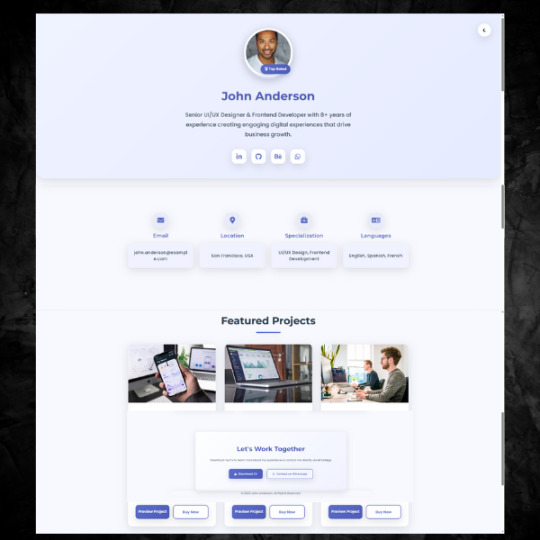
Profile-Pro is a professionally designed personal portfolio template that showcases your skills, experience, and projects with elegance and impact. Crafted for modern professionals who want to make a lasting impression, this template combines aesthetic appeal with functional excellence.
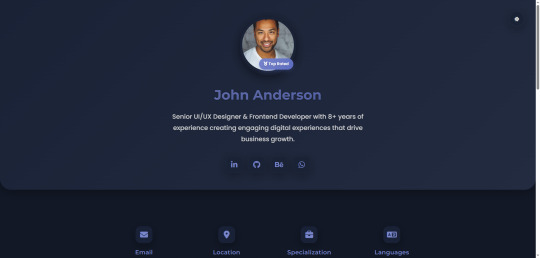
Why Choose Profile-Pro?
Modern Design Aesthetics: Sleek interface with harmonious colors and sophisticated effects
Exceptional User Experience: Perfect contrast, subtle shadows, and smooth transitions
Fully Responsive: Flawless performance on mobile, tablet, and desktop devices
Day/Night Mode: Eye-friendly theme switching with automatic preference saving
Professional Project Showcase: Elegant portfolio section to highlight your best work
Easy Customization: Simple modification to match your personal brand identity
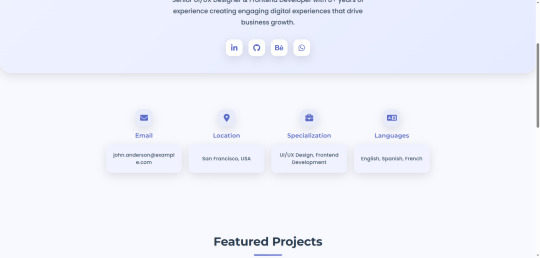
Key Features & Capabilities
Professional Design
Modern UI with sophisticated styling
Harmonious color scheme with customization options
Precise shadows creating depth and elegance
Theme Switching
One-click toggle between light/dark modes
Automatic user preference saving
Seamless design consistency across both themes
Fully Responsive
Adaptive layout for all screen sizes
Consistent user experience across devices
Smart element and text scaling
Project Showcase
Elegant project grid layout
Project cards with impressive hover effects
Clear action buttons (Preview/Buy)

Contact Information
Innovative information card design
Icon-based contact details
Social media integration
Performance Optimized
Lightweight codebase for fast loading
Clean HTML/CSS without frameworks
SEO-friendly structure
License
This template is released under the MIT License - free for personal and commercial use with attribution. See LICENSE file for details.
Quick Start
Download the template files
Customize content in index.html
Replace images with your own
Deploy to any hosting service

Transform your online presence with Profile-Pro - where professionalism meets design excellence!
#css#html#html css#htmlcoding#js#Profile page#landing page design#ui ux design#design#template#template design#landing page#landing page builder#landing pages#panel#coding
0 notes
Text
Find the Top 5 Latest Mobile App Development Software in 2025 — Expert Picks by TimD — Tim Digital
Choosing the right mobile app development software in 2025 is more than just a technical decision — it’s a strategic advantage. With the growing pressure to deliver faster, reduce bugs, and maintain UI consistency across devices, developers and companies alike are re-evaluating their tech stacks.

Why the Right Mobile Development Stack Makes All the Difference
Many development teams struggle not because of a lack of skill but due to poor tooling and platform fragmentation. Common issues include:
Too much time spent on duplicate codebases
Difficulty managing bugs across platforms
Low design consistency between iOS and Android versions
A better stack can lead to faster time-to-market, fewer bugs, and improved collaboration across teams.
Snapshot: 5 Game-Changing Mobile Development Frameworks
In 2025, five standout mobile development frameworks are leading the way.
Flutter, backed by Google, offers hot reload, expressive visuals, and UI consistency — making it ideal for cross-platform UI precision. React Native, developed by Meta, is JS/TS-based and features fast refresh and a robust plugin ecosystem, best suited for teams transitioning from web to mobile. .NET MAUI, Microsoft’s enterprise-grade solution, combines native speed with C# and deep integration into the Microsoft ecosystem, perfect for unified experiences across mobile and desktop. For Apple-centric development, Swift stands out with hardware-level API access and deep iOS integration, delivering high-performance, iOS-only applications. Lastly, Kotlin, Google’s preferred language for Android, is known for its concise syntax and Jetpack Compose support, making it the go-to choice for scalable, Android-first projects.
1. Flutter — Deliver Visually Consistent Cross-Platform Apps
Backed by Google, Flutter continues to lead the way for teams needing high-performance mobile apps from a single Dart codebase. With its built-in Skia rendering engine, it doesn’t rely on native UI components — giving you full control over visuals on both Android and iOS.
Why It’s a Top Pick:
Rapid UI iteration with Hot Reload
Mature ecosystem on pub.dev
Excellent for MVPs, startups, and custom-designed apps
2. React Native — A Natural Fit for Web Development Teams
Created by Meta, React Native allows JavaScript developers to build native mobile apps without switching tech stacks. It’s ideal for web teams transitioning into mobile, especially with tools like Expo simplifying builds.
Best Use Cases:
Fast deployment using React-based components
Shared codebase between web and mobile
Lightweight apps needing high iteration cycles
3. .NET MAUI — Microsoft’s Unified Solution for Desktop and Mobile
.NET MAUI enables enterprise-grade cross-platform development using C# and XAML. It compiles to native code, ensuring performance, while simplifying development for organizations already using Microsoft tools and Azure.
Why Enterprises Prefer It:
Strong support for desktop/mobile hybrid builds
Full access to native APIs
Streamlined with Visual Studio and Azure DevOps
4. Swift — The Gold Standard for Native iOS App Development
Developed by Apple, Swift is the go-to for building fluid, fast, and fully integrated iOS apps. Combined with SwiftUI or UIKit, it’s the most reliable way to deliver App Store-ready applications with deep device capabilities.
Ideal For:
iOS-only apps
Products that leverage ARKit, Core ML, or HealthKit
Premium apps requiring pixel-perfect animations
5. Kotlin — For Next-Level Native Android Performance
Endorsed by Google and developed by JetBrains, Kotlin is a modern language designed for Android. It brings null safety, concise syntax, and coroutine-based async capabilities, making it a favorite among Android developers in 2025.
Where It Shines:
Clean migration path from Java
Jetpack Compose support for UI innovation
Great for complex, scalable Android apps
Native vs. Cross-Platform vs. Hybrid — What Should You Choose?
When it comes to choosing the right development approach, your decision should align with your product roadmap, team capabilities, and performance expectations. Native development offers the best UX quality and strong scalability, making it ideal for performance-intensive apps — but it comes with higher maintenance needs and moderate development speed. Cross-platform frameworks like Flutter and React Native strike a balance by allowing faster development, lower maintenance, and good scalability, although UX quality may slightly lag behind native builds. On the other hand, hybrid frameworks such as Ionic are fast to develop and easy to maintain but offer limited user experience and only moderate scalability — making them suitable for basic MVPs or internal tools where performance is not critical.
Expert Tip: If your app relies on camera, AR, or sensors — go native. For time-to-market and design parity, cross-platform tools like Flutter or React Native offer the best ROI.
What to Look for in Mobile App Development Platforms
When selecting mobile development tools in 2025, top agencies and development teams recommend looking for:
Real-time debugging and emulation support
Comprehensive UI libraries
CI/CD compatibility (e.g., App Center, GitHub Actions)
Easy deployment to Play Store and App Store
Third-party plugin support for maps, payments, authentication, etc.
Final Thoughts
Whether you’re launching a feature-rich Android app, building an enterprise mobile suite, or rapidly shipping a cross-platform MVP — choosing the right development platform in 2025 is key to avoiding unnecessary rework and scaling with confidence.
If you’re looking for expert guidance, several agencies — like TimD — Tim Digital — are offering tailored consulting and mobile app solutions built on the most robust tools in the market.
👉 Looking for the Best Mobile Apps Development Services in Kolkata? Explore trusted mobile development experts who can help architect your next big idea, fast and friction-free.
Follow us for insights and expert strategies on LinkedIn, Facebook, Instagram, YouTube, Pinterest, and Twitter (X).
#MobileAppDevelopment#AppDevelopmentTools#CrossPlatformDevelopment#FlutterDevelopment#SwiftProgramming#KotlinAndroid#DotNetMAUI#iOSDevelopment#AndroidDevelopment#TechStack2025#TimDigital#TimDTech#SoftwareDevelopment
0 notes
Text
Laravel Programming: A Comprehensive Guide
Table of Contents
Introduction to Laravel
Why Use Laravel?
Installing Laravel
Laravel Folder Structure
Routing and Controllers
Blade Templating Engine
Laravel Models and Eloquent ORM
Migrations and Database Seeding
Request Lifecycle and Middleware
Form Handling and Validation
Authentication and Authorization
Laravel Artisan CLI
RESTful API Development in Laravel
Testing in Laravel
Deployment and Performance Optimization
Laravel Ecosystem and Tools
Conclusion
1. Introduction to Laravel
Laravel is an open-source PHP framework built by Taylor Otwell. It follows the MVC (Model-View-Controller) architectural pattern, which promotes a clean separation between business logic, UI, and data.
Laravel aims to make development faster and easier by providing powerful tools such as:
Routing
Middleware
Authentication
Blade templating
ORM (Eloquent)
Queues
Artisan command-line tool
Laravel is currently one of the most popular PHP frameworks and powers thousands of web applications globally.
2. Why Use Laravel?
Benefits of Laravel:
Clean and Elegant Syntax: Laravel simplifies complex tasks.
MVC Architecture: Ensures separation of concerns.
Eloquent ORM: Elegant database abstraction layer.
Blade Templating: Lightweight yet powerful templating engine.
Built-in Authentication & Authorization: Secure and easy to implement.
Community and Ecosystem: Laravel has a rich ecosystem like Nova, Horizon, Forge, Envoyer, etc.
Testing Ready: PHPUnit integration for test-driven development (TDD).
0 notes
Text
Build Clean, Modern UIs with Golden Ratio Scaling - LiftKit CSS
LiftKit CSS is a lightweight, 100% free CSS framework developed by Chainlift. It’s a set of utility classes and UI components designed with golden ratio scaling, which helps you create clean, modern web projects. Utility Classes: Color Typography Spacing Grids Sizes Border Radius Aspect Ratio Shadow Layout Blocks Display UI Elements: Cards Badges Stickers Buttons Navigation Snackbar More…
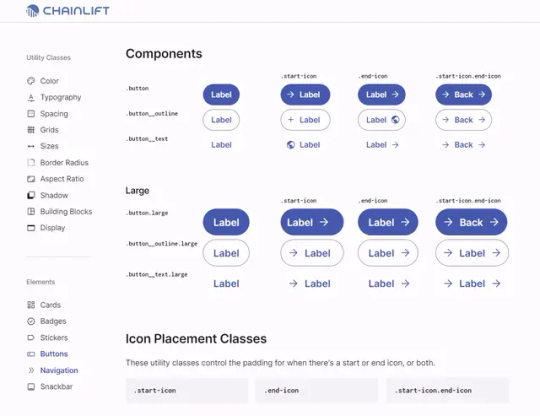
View On WordPress
2 notes
·
View notes
Text
Why Choosing the Right MERN Stack Development Company Matters for Your Business
In today’s digital-first world, building high-performing, scalable, and responsive web applications is a must. To achieve this, businesses are increasingly turning to modern full-stack frameworks like MERN. But success with this stack doesn’t come just from using the technology—it comes from choosing the right MERN stack development company to bring your vision to life.
Brain Inventory stands out as a leading provider of MERN stack development services, helping businesses across industries develop cutting-edge digital products using MongoDB, Express.js, React, and Node.js. With an expert team, proven processes, and industry-specific insights, we empower you to go to market faster with web solutions that scale effortlessly.

What is the MERN Stack and Why Should You Use It?
The MERN stack is a powerful, JavaScript-based full-stack solution that combines
MongoDB—A flexible NoSQL database that stores JSON-style data.
Express.js—A lightweight backend framework built on Node.js.
React.js—A frontend library used to build interactive user interfaces.
Node.js—A high-performance JavaScript runtime for building scalable server-side applications.
At Brain Inventory, our MERN stack experts use this framework to create web applications that are seamless, scalable, and secure. Because the entire stack is JavaScript-based, development is faster, more efficient, and easier to maintain across all layers.
Why Brain Inventory Is the Best MERN Stack Development Company for Your Project
When you choose Brain Inventory as your MERN stack development partner, you gain more than just technical expertise—you gain a team that’s genuinely invested in your success.
🔹 End-to-End MERN Stack Development Services
We offer complete MERN stack development services, including planning, UI/UX, front-end development, back-end architecture, API integration, and cloud deployment.
🔹 Skilled & Dedicated Developers
Our dedicated MERN stack developers are highly trained in React, Node.js, and MongoDB. Whether you need an MVP or a full-scale enterprise platform, Brain Inventory ensures top-tier development from start to finish.
🔹 Agile Development with Real-Time Communication
At Brain Inventory, we follow agile workflows with sprints, iterations, and continuous feedback to keep your project on track. Our clients stay informed at every step.
🔹 Flexible Hiring Models
You can choose hourly, part-time, or full-time engagement models based on your project’s size and scope. Hire developers or full teams as needed—with complete transparency.
Benefits of Choosing MERN Stack for Your Web Development Needs
When you partner with Brain Inventory for MERN stack development services, you get:
✅ Unified JavaScript Development: Code reuse across client and server.
✅ Lightning-Fast Performance: Asynchronous Node.js and React’s virtual DOM.
✅ Component-Based Architecture: Reusable and scalable UI elements.
✅ Cloud-Ready: Built-in support for scalable deployment environments.
✅ Real-Time Capability: Ideal for live dashboards, chat apps, and more.
We leverage these strengths to build solutions that not only meet current requirements but also anticipate future growth.
Custom MERN Stack Development Services by Brain Inventory
As a full-service MERN stack development company, Brain Inventory offers:
🔹 Custom Web App Development
🔹 Real-Time Application Development
🔹 Enterprise-Grade Solutions
🔹 API Integration & Third-Party Services
🔹 Progressive Web App (PWA) Development
🔹 Ongoing Maintenance & Support
Whether you’re in fintech, healthcare, education, or eCommerce, our team tailors solutions that align with your industry and audience.
Industries That Rely on Brain Inventory’s MERN Stack Expertise
Brain Inventory has delivered powerful MERN-based solutions for clients in:
🏥 Healthcare (Patient Portals, EMRs)
🛒 E-Commerce (Custom Online Stores, Marketplaces)
🎓 EdTech (Learning Management Systems)
🏦 FinTech (Data Dashboards, Transaction Portals)
📊 SaaS Products (CRM, ERP, BI Tools)
Our developers combine domain knowledge with MERN stack excellence to craft applications that truly deliver value.
Conclusion: Let Brain Inventory Power Your Next Digital Product
The success of your digital product depends not just on technology, but on the team implementing it. As a top-rated MERN stack development company, Brain Inventory is your trusted technology partner. We’ve helped startups, SMEs, and enterprises launch scalable, secure, and intuitive applications using our proven MERN stack expertise.
If you're looking for dependable MERN stack development services with flexible engagement, transparent processes, and a skilled team—Brain Inventory is here to help.
Contact Brain Inventory today to discuss your project and unlock the full potential of MERN stack for your business success.
0 notes
Text
Boost Performance with Alternatives to ReactJS 🌟
Alternatives to ReactJS enable you to cut through redundancy and select a framework that performs just the way you need it. Whether you’re designing a lightweight UI or scaling a large application, these alternatives can streamline delivery, cut load times, and boost adaptability. It’s a powerful way to match your stack to your goals, not the other way around. If you’re ready to maximize performance and innovate faster, consider alternatives to ReactJS today.
🚀 Begin exploring now and unlock your UI’s potential!
0 notes
Text
Looking to Upgrade Your Old UI? Time to Hire VueJS Developers
In today’s digital world, your website or application’s user interface (UI) is often the first impression your brand makes. If your platform still uses outdated UI elements, slow-loading pages, or poor responsiveness on mobile, you’re not just behind the curve, you're losing customers.
A modern user interface is more than just a new look. It’s about creating an engaging, dynamic experience that encourages interaction, boosts conversion rates, and builds long-term customer loyalty.
If you’re thinking about upgrading your UI, now is the perfect time to hire VueJS developers. VueJS is one of the most flexible and powerful frontend frameworks available, and it has quickly become the go-to choice for businesses aiming to create responsive, high-performing interfaces.
In this blog, we’ll cover why VueJS is the smart choice for UI upgrades, what makes VueJS developers valuable, and how the right team can transform your digital experience.
What Is VueJS?
VueJS is an easy to use and adaptable JavaScript tool for building user interfaces and one page applications. Unlike heavier frameworks, VueJS is incredibly fast, flexible, and easy to integrate into existing projects making it ideal for UI modernization.
Vue’s reactive components make your website feel more like a native app fluid, intuitive, and highly responsive.
Why Your Old UI Is Hurting Your Business
Let’s start with the obvious: if your UI looks and feels old, your users will notice. Outdated user interfaces can lead to:
Poor first impressions
High bounce rates
Low customer engagement
Negative brand perception
Missed conversion opportunities
Today’s users expect sleek, responsive, and interactive digital experiences. If your app or website doesn’t deliver that, they’ll bounce to a competitor that does.

Why VueJS is Perfect for UI Upgrades
Upgrading your UI isn’t just about visual design, it's about performance, interactivity, and ease of use. VueJS checks all those boxes and more. Here’s why:
1. Lightweight and Fast
VueJS is extremely fast to load and execute. It minimizes page load time, which is critical for both user experience and SEO.
2. Modular and Scalable
Vue’s component-based architecture allows developers to build and manage sections of the UI independently. This makes upgrades seamless and scalable.
3. Easy Integration
Already have an app built on another framework? VueJS can be added to part of your codebase without starting from scratch.
4. Real-Time UI Updates
Vue’s reactive data binding lets your UI update instantly in response to user actions, which leads to a much smoother experience.
5. Strong Ecosystem
With tools like Vue Router (for navigation), Vuex (for state management), and Nuxt.js (for SSR and SEO), Vue offers a complete toolkit for high-performance applications.
Key Signs It’s Time to Hire VueJS Developers
Wondering if it’s the right time to modernize your app or site? Here are signs your UI needs a Vue-powered upgrade:
Your website/app looks outdated or isn’t mobile-friendly
High bounce rates or low user engagement
Long page load times
Poor accessibility or confusing navigation
Difficulty adding new features or scaling your platform
If any of these sound familiar, it's time to hire VueJS developers to breathe new life into your frontend.
What to Expect When You Hire VueJS Developers
Professional VueJS developers bring a mix of technical expertise and design thinking to your project. Here’s what you can expect:
1. UI/UX Strategy
They’ll audit your current UI and recommend ways to improve usability, navigation, layout, and responsiveness.
2. Modular Redesign
Your platform will be rebuilt using reusable Vue components making future updates faster and more cost-effective.
3. Performance Boost
Vue's fast rendering boosts website speed and user experience, which helps lower bounce rates and improves SEO.
4. Cross-Device Compatibility
Vue developers ensure your site works flawlessly on desktops, tablets, and smartphones.
5. Integration with APIs & Backends
VueJS works well with any backend Node.js, Laravel, Django, Firebase you name it. Developers can create seamless data flows between UI and server.
Real-World Use Cases of VueJS in UI Upgrades
eCommerce Platforms
Brands use VueJS to build snappy product galleries, smart filters, interactive carts, and single-page checkouts.
SaaS Dashboards
Vue powers data-heavy dashboards with charts, live updates, and clean UI for software companies.
News Portals & Blogs
VueJS makes content-heavy websites fast and easy to navigate, with infinite scrolling and category filtering.
EdTech & Learning Platforms
Vue allows for real-time quizzes, scoreboards, and course progress tracking all with smooth user interaction.
Tips for Hiring the Right VueJS Developers
Check their portfolio: Look for live Vue projects, especially in your niche.
Test their UI/UX knowledge: Not just coding skills, good developers understand user behavior.
Ask about Vue ecosystem: Ensure they know Vuex, Vue Router, and Nuxt.js.
Start with a test task: A small module or feature helps you evaluate their speed and code quality.
Consider time zone and communication: Daily standups or progress reports are a must.
How to Manage a VueJS UI Upgrade Project
Here’s a step-by-step breakdown:
Review your current interface: Spot areas where users face issues or give negative feedback.
Define your goals: Faster load times, mobile optimization, better layout, etc.
Build wireframes or mockups: Collaborate with designers or use existing ideas.
Hire VueJS developers: Choose based on skills, availability, and budget.
Develop in sprints: Upgrade the UI module-by-module, testing regularly.
Deploy and gather feedback: Monitor analytics, fix issues, and plan improvements.
FAQs About Hiring VueJS Developers
1. Can VueJS be used with existing HTML and JavaScript?
Yes! Vue is easy to integrate into projects that use traditional JavaScript. You can slowly add Vue features without needing to rebuild everything from scratch.
2. How long does it take to upgrade a UI with VueJS?
It depends on the size and complexity of your platform. A basic UI revamp might take 3–5 weeks, while large applications may take 2–3 months.
3. Is VueJS scalable for large enterprise applications?
Absolutely. Vue’s modular design, combined with Vuex and Nuxt.js, makes it suitable for large, scalable enterprise-level applications.
4. Do I need a backend developer too?
Only if your project requires data fetching, API integrations, or server-side logic. Vue handles the frontend, while backend tech like Node.js or Laravel manages data.
Final Thoughts
In the world of web and app development, first impressions matter. Your UI is not just a design element, it's a business tool. An outdated or clunky interface can slow you down, while a modern VueJS-powered UI can supercharge user engagement, boost conversions, and set you apart from competitors.
So if you’re ready to move from old and sluggish to sleek and stunning, now’s the time to hire VueJS developers who can help you do it right.
0 notes
Text
Top Front-End Frameworks Web Development Companies Use in 2025
The front-end landscape continues to evolve rapidly, with user expectations pushing web applications to be faster, more interactive, and visually seamless across devices. In 2025, choosing the right front-end framework is a strategic decision that impacts performance, scalability, and developer efficiency. That’s why every seasoned Web Development Company evaluates and adopts frameworks that align with both technical requirements and user experience goals.
From enterprise-grade portals to dynamic eCommerce platforms and progressive web apps, front-end frameworks power the interface users directly engage with. Below, we explore the top front-end frameworks dominating the web development space in 2025—and why agencies rely on them.
1. React.js
Still the industry favorite in 2025, React continues to dominate front-end development. Backed by Meta (Facebook), React is a component-based JavaScript library for building fast, interactive UIs.
Why companies use it:
Strong community support and third-party integrations
Highly reusable components and custom hooks
Great compatibility with backends and headless CMS
Ideal for SPAs, PWAs, and enterprise dashboards
Bonus: React also powers frameworks like Next.js, which brings SSR (server-side rendering), static site generation, and improved SEO to the React ecosystem.
2. Vue.js
Vue has steadily gained popularity thanks to its simplicity, performance, and developer-friendly design. In 2025, Vue 3—with its Composition API and improved TypeScript support—makes it a strong choice for mid-scale projects and agile teams.
Why companies use it:
Lightweight and easy to learn
Reactive two-way data binding
Great for progressive migration in legacy apps
Vue CLI and ecosystem tools enhance productivity
Ideal for: SaaS applications, admin panels, and interactive marketing sites.
3. Next.js
Although technically a framework built on React, Next.js deserves a separate mention due to its dominance in building high-performance, SEO-friendly web applications.
Why companies use it:
Built-in support for SSR, SSG, and ISR
Seamless routing and dynamic page generation
API routes for backend-like features
Excellent for headless CMS integrations and eCommerce
Trend in 2025: Many Jamstack-based websites now rely on Next.js paired with GraphQL and CMS tools like Sanity or Strapi.
4. Svelte & SvelteKit
Svelte takes a unique approach—it compiles your code at build time, eliminating the need for a virtual DOM. The result? Ultra-fast and lightweight apps with excellent runtime performance.
Why companies use it:
Less boilerplate code, clean syntax
Faster load times and smaller bundle sizes
SvelteKit brings routing, server-side rendering, and file-based API integration
Use case: Startups looking for speed, performance, and simplicity in modern SPAs.
5. Angular
Angular, maintained by Google, remains a staple in enterprise web development in 2025. While it's more complex and opinionated than React or Vue, it provides everything out of the box—from routing and state management to HTTP clients and dependency injection.
Why companies use it:
Built-in tooling for testing, forms, and HTTP
TypeScript-first architecture
Great for large-scale, complex applications
Best for: Enterprise-level apps with large teams and strict development protocols.
6. Remix
Remix is a relatively new but rapidly adopted React framework focusing on performance, nested routing, and better use of the browser’s native capabilities. In 2025, many agencies use Remix for building dynamic, data-driven apps with great SEO and loading speed.
Why companies use it:
Streamlined data loading methods
Improved error handling
Great SEO out of the box
Works well with modern APIs and backends
Gaining ground: Especially among React teams seeking an alternative to Next.js.
7. Astro
Astro is one of the rising stars in front-end frameworks as of 2025. It allows developers to ship zero JavaScript by default and only hydrate interactive components as needed. It supports multiple frameworks (React, Vue, Svelte) in the same project.
Why companies use it:
Partial hydration = faster sites
Ideal for content-heavy sites and blogs
Headless CMS integration is seamless
Perfect for: Static sites, marketing pages, and performance-first websites.
Final Thoughts
The front-end frameworks used in 2025 reflect a shift toward performance, flexibility, SEO-friendliness, and developer ergonomics. Whether you're building a blazing-fast content site or a complex dashboard, the right framework accelerates development, improves UX, and ensures scalability.
Partnering with a forward-thinking Web Development Company ensures that your project is built using the best-suited technology stack. These experts evaluate your business needs, future scalability, SEO requirements, and user expectations to recommend the optimal front-end framework—ensuring your digital product doesn’t just look good, but performs exceptionally.
0 notes